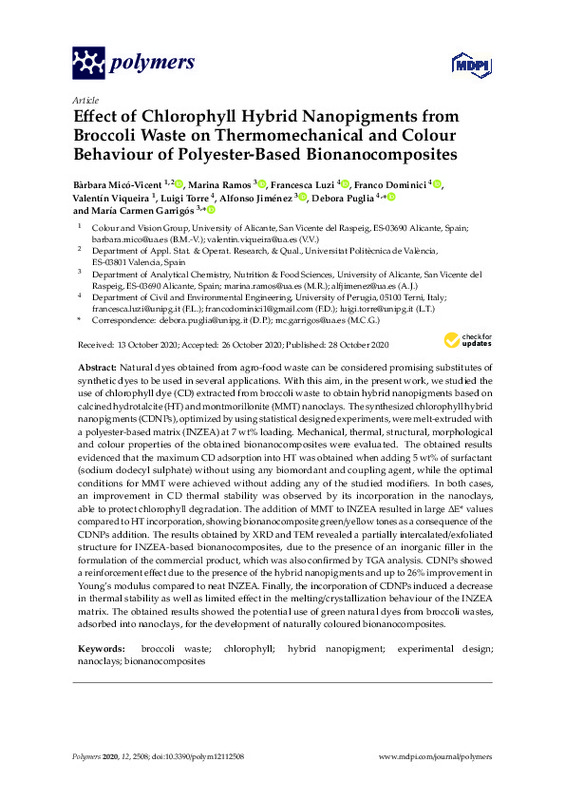JavaScript is disabled for your browser. Some features of this site may not work without it.
Buscar en RiuNet
Listar
Mi cuenta
Estadísticas
Ayuda RiuNet
Admin. UPV
Effect of Chlorophyll Hybrid Nanopigments from Broccoli Waste on Thermomechanical and Colour Behaviour of Polyester-Based Bionanocomposites
Mostrar el registro sencillo del ítem
Ficheros en el ítem
| dc.contributor.author | Micó-Vicent, B.
|
es_ES |
| dc.contributor.author | Ramos, Marina
|
es_ES |
| dc.contributor.author | Luzi, Francesca
|
es_ES |
| dc.contributor.author | Dominici, Franco
|
es_ES |
| dc.contributor.author | Viqueira, Valentín
|
es_ES |
| dc.contributor.author | Torre, Luigi
|
es_ES |
| dc.contributor.author | Jiménez, Alfonso
|
es_ES |
| dc.contributor.author | Puglia, Debora
|
es_ES |
| dc.contributor.author | Garrigós, María Carmen
|
es_ES |
| dc.date.accessioned | 2021-11-05T14:11:09Z | |
| dc.date.available | 2021-11-05T14:11:09Z | |
| dc.date.issued | 2020-11 | es_ES |
| dc.identifier.uri | http://hdl.handle.net/10251/176445 | |
| dc.description.abstract | [EN] Natural dyes obtained from agro-food waste can be considered promising substitutes of synthetic dyes to be used in several applications. With this aim, in the present work, we studied the use of chlorophyll dye (CD) extracted from broccoli waste to obtain hybrid nanopigments based on calcined hydrotalcite (HT) and montmorillonite (MMT) nanoclays. The synthesized chlorophyll hybrid nanopigments (CDNPs), optimized by using statistical designed experiments, were melt-extruded with a polyester-based matrix (INZEA) at 7 wt% loading. Mechanical, thermal, structural, morphological and colour properties of the obtained bionanocomposites were evaluated. The obtained results evidenced that the maximum CD adsorption into HT was obtained when adding 5 wt% of surfactant (sodium dodecyl sulphate) without using any biomordant and coupling agent, while the optimal conditions for MMT were achieved without adding any of the studied modifiers. In both cases, an improvement in CD thermal stability was observed by its incorporation in the nanoclays, able to protect chlorophyll degradation. The addition of MMT to INZEA resulted in large Delta E* values compared to HT incorporation, showing bionanocomposite green/yellow tones as a consequence of the CDNPs addition. The results obtained by XRD and TEM revealed a partially intercalated/exfoliated structure for INZEA-based bionanocomposites, due to the presence of an inorganic filler in the formulation of the commercial product, which was also confirmed by TGA analysis. CDNPs showed a reinforcement effect due to the presence of the hybrid nanopigments and up to 26% improvement in Young's modulus compared to neat INZEA. Finally, the incorporation of CDNPs induced a decrease in thermal stability as well as limited effect in the melting/crystallization behaviour of the INZEA matrix. The obtained results showed the potential use of green natural dyes from broccoli wastes, adsorbed into nanoclays, for the development of naturally coloured bionanocomposites. | es_ES |
| dc.description.sponsorship | The authors express their gratitude to the Bio Based Industries Consortium and European Commission for the financial support to the project BARBARA: Biopolymers with advanced functionalities for building and automotive parts processed through additive manufacturing. This project received funding from the Bio Based Industries Joint Undertaking under the European Union's Horizon 2020 research and innovation programme under grant agreement No 745578. | es_ES |
| dc.language | Inglés | es_ES |
| dc.publisher | MDPI AG | es_ES |
| dc.relation.ispartof | Polymers | es_ES |
| dc.rights | Reconocimiento (by) | es_ES |
| dc.subject | Broccoli waste | es_ES |
| dc.subject | Chlorophyll | es_ES |
| dc.subject | Hybrid nanopigment | es_ES |
| dc.subject | Experimental design | es_ES |
| dc.subject | Nanoclays | es_ES |
| dc.subject | Bionanocomposites | es_ES |
| dc.subject.classification | EXPRESION GRAFICA EN LA INGENIERIA | es_ES |
| dc.title | Effect of Chlorophyll Hybrid Nanopigments from Broccoli Waste on Thermomechanical and Colour Behaviour of Polyester-Based Bionanocomposites | es_ES |
| dc.type | Artículo | es_ES |
| dc.identifier.doi | 10.3390/polym12112508 | es_ES |
| dc.relation.projectID | info:eu-repo/grantAgreement/EC/H2020/745578/EU/Biopolymers with advanced functionalities for building and automotive parts processed through additive manufacturing/ | es_ES |
| dc.rights.accessRights | Abierto | es_ES |
| dc.contributor.affiliation | Universitat Politècnica de València. Departamento de Ingeniería Gráfica - Departament d'Enginyeria Gràfica | es_ES |
| dc.description.bibliographicCitation | Micó-Vicent, B.; Ramos, M.; Luzi, F.; Dominici, F.; Viqueira, V.; Torre, L.; Jiménez, A.... (2020). Effect of Chlorophyll Hybrid Nanopigments from Broccoli Waste on Thermomechanical and Colour Behaviour of Polyester-Based Bionanocomposites. Polymers. 12(11):1-19. https://doi.org/10.3390/polym12112508 | es_ES |
| dc.description.accrualMethod | S | es_ES |
| dc.relation.publisherversion | https://doi.org/10.3390/polym12112508 | es_ES |
| dc.description.upvformatpinicio | 1 | es_ES |
| dc.description.upvformatpfin | 19 | es_ES |
| dc.type.version | info:eu-repo/semantics/publishedVersion | es_ES |
| dc.description.volume | 12 | es_ES |
| dc.description.issue | 11 | es_ES |
| dc.identifier.eissn | 2073-4360 | es_ES |
| dc.identifier.pmid | 33126539 | es_ES |
| dc.identifier.pmcid | PMC7692781 | es_ES |
| dc.relation.pasarela | S\424180 | es_ES |
| dc.contributor.funder | European Commission | es_ES |








